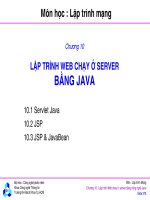Lecture Operating system: Chapter 6 - TS. Nguyễn Văn Hiệp
Bạn đang xem bản rút gọn của tài liệu. Xem và tải ngay bản đầy đủ của tài liệu tại đây (3.37 MB, 46 trang )
Chapter 6
File Systems
6.1 Files
6.2 Directories
6.3 File system implementation
6.4 Example file systems
Longterm Information Storage
•
Must store large amounts of data
•
Information stored must survive the
termination of the process using it
•
Multiple processes must be able to access
the information concurrently
File Naming
Typical file extensions.
File Structure
• Three kinds of files
– byte sequence
– record sequence
– tree
File Types
(a) An executable file (b) An archive
File Access
• Sequential access
– read all bytes/records from the beginning
– cannot jump around, could rewind or back up
– convenient when medium was mag tape
• Random access
– bytes/records read in any order
– essential for data base systems
– read can be …
• move file marker (seek), then read or …
• read and then move file marker
File Attributes
Possible file attributes
File Operations
1. Create
2. Delete
3. Open
4. Close
5. Read
6. Write
7. Append
8. Seek
9. Get attributes
10.Set Attributes
11.Rename
An Example Program Using File System Calls (1/2)
An Example Program Using File System Calls (2/2)
MemoryMapped Files
(a) Segmented process before mapping files
into its address space
(b) Process after mapping
existing file abc into one segment
creating new segment for xyz
Directories
SingleLevel Directory Systems
• A single level directory system
– contains 4 files
– owned by 3 different people, A, B, and C
Twolevel Directory Systems
Letters indicate owners of the directories and files
Hierarchical Directory Systems
A hierarchical directory system
Path Names
A UNIX directory tree
Directory Operations
1.
2.
3.
4.
Create
Delete
Opendir
Closedir
5. Readdir
6. Rename
7. Link
8. Unlink
File System Implementation
A possible file system layout
Implementing Files (1)
(a) Contiguous allocation of disk space for 7 files
(b) State of the disk after files D and E have been removed
Implementing Files (2)
Storing a file as a linked list of disk blocks
Implementing Files (3)
Linked list allocation using a file allocation table in RAM
Implementing Files (4)
An example inode
Implementing Directories (1)
(a) A simple directory
fixed size entries
disk addresses and attributes in directory entry
(b) Directory in which each entry just refers to an inode
Implementing Directories (2)
• Two ways of handling long file names in directory
– (a) Inline
– (b) In a heap
Shared Files (1)
File system containing a shared file
Shared Files (2)
(a) Situation prior to linking
(b) After the link is created
(c)After the original owner removes the file









